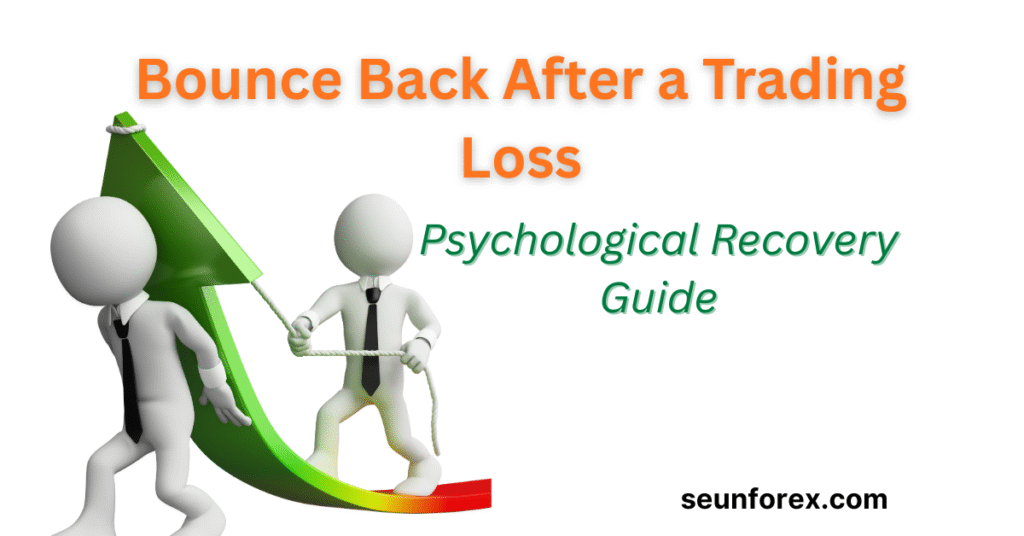
“The market doesn’t punish mistakes; it punishes hesitation and emotional weakness.” — Anonymous
Trading Loss Recovery is the key to transforming red numbers and emotional chaos into a mental edge. Great traders are like deep-sea divers: on the surface, a trading loss may feel like panic, margin calls, and flashing charts. Everyone sees the same losses, but few know how to turn turmoil into actionable insight. The real edge lies beneath the surface—through disciplined reflection, structured journaling, and systematic process analysis that reshapes your mind, sharpens focus, and recalibrates emotional responses.
Psychological recovery in trading is exactly what trading loss recovery entails: a deliberate, structured process that rewires emotional reactions so discipline, clarity, and calm execution become second nature—even under stress, volatility, and uncertainty. The goal isn’t to suppress emotions but to convert emotional turbulence into actionable insight.
Structured trading loss recovery allows traders to learn faster, act smarter, and turn losses into resilience. A well-managed loss doesn’t define your skill—it educates, reshapes your approach, and strengthens your trading performance over time.
🎯 What Does Recovery Really Mean?
Psychological recovery goes far beyond simply “getting over it.” Many traders think time alone heals emotional setbacks, but true recovery is active, deliberate, and measurable. It focuses on three intertwined pillars:
- Emotional recalibration
After a significant loss, your emotional state can range from shock to denial, frustration, or even anger. Emotional recalibration is about moving from these reactive states to acceptance and equilibrium. A calm mind allows rational decision-making, minimizes revenge trading, and prevents cascading losses. - Cognitive clarity
A key challenge post-loss is separating mistakes you control (process errors, position sizing) from market randomness (unexpected news, gaps, macro events). Cognitive clarity enables you to analyze losses without bias and to identify repeatable patterns that lead to improvement. - Behavioral correction
Emotional turmoil often manifests in impulsive, undisciplined actions: chasing losses, over-leveraging, or skipping your checklist. Behavioral correction rebuilds discipline in execution, ensuring adherence to trading rules and protecting capital.
Pradeep Bonde (Stockbee) emphasizes systematic preparation. His work on structured market preparation inspired this methodology, which can be applied directly after drawdowns to rebuild both confidence and process fidelity.
🧩 Why Structured Recovery Works (The Brain Science Bit)
Think of your brain like a chess grandmaster studying thousands of patterns. Each emotional spike during a trading loss is like a misplayed move on the board. Structured recovery works because it wires your brain to recognize triggers, evaluate them rationally, and respond effectively.
- Emotional recognition: Your mind learns to identify spikes in fear, anger, or revenge impulses before they affect your trades.
- Process-driven override: Conscious adherence to rules replaces impulsive reactions.
- Confidence recalibration: By reflecting systematically, execution improves, hesitation declines, and overtrading is minimized.
Through repeated journaling and review:
- You spot emotional triggers before they hijack your trades.
- You internalize rules and process steps, making them automatic under pressure.
- Trading becomes deliberate rather than reactionary, even in volatile markets.
This is not theory—it’s neuroplasticity in action. The more consistently you practice structured recovery, the faster your brain rewires to respond optimally to future losses.
🧪 The Two Core Trading Loss Recovery Projects You Can Start Today
Below are two actionable, measurable recovery projects. One focuses on immediate emotional stabilization, and the other on longer-term behavioral improvement.
1) 🧘 Daily Emotional Journaling for Short-Term Trading Loss Recovery
Question: How can I stabilize emotions immediately after a trading loss?
Step-by-step process:
- Record trade outcomes and emotional state on a scale of 1–10 (1 = calm, 10 = highly stressed).
- Identify triggers: Was it the market setup, fatigue, time of day, news, or leverage?
- Reflect nightly: Did you follow your trading rules? Did you overtrade, revenge trade, or hesitate?
- Plan corrective actions for the next day: micro-trades, lower leverage, or skipping a session if emotionally compromised.
Expected insights from journaling:
- Patterns in impulsive trades
- Emotional hotspots (time, instruments, market conditions)
- Immediate behavioral adjustments to regain control
Pro Tip: Tag recurring triggers with labels like “gap-fade anger,” “overnight news panic,” or “Friday fatigue trades” for weekly pattern analysis.
Illustrative Scenario:
Imagine a trader loses $1,200 on a highly volatile biotech stock. Journaling reveals the trigger: a gap-down caused a panic exit. Emotional rating: 9/10. Corrective action: only trade biotech with tight stops for the next 3 days, review each trade before entry. Within a week, emotional spikes reduce, and the trader executes calm, rules-based entries, even in similar setups.
2) 🏆 Post-Loss Process Audit for Medium/Long-Term Trading Loss Recovery
Question: How can I prevent repeated breakdowns over weeks?
Step-by-step process:
- Review each loss: Distinguish process errors (entry mistakes, wrong position sizing) from market randomness (unexpected gaps, news).
- Build a checklist: Include entry criteria, stop-loss, target, risk allocation, and position sizing.
- Start small: Begin with low-risk trades (≤0.25R) to restore confidence without jeopardizing capital.
- Gradual scaling: Resume normal trading once checklist adherence is consistently achieved.
Expected insights:
- Certain setups consistently violate rules (e.g., chasing momentum on gaps).
- Repeated emotional reactions linked to triggers like fatigue or news.
- Incremental progress restores confidence and ensures adherence to trading process.
Illustrative Scenario:
A trader consistently over-leverages after overnight news. Process audit identifies pattern: “revenge trade after loss + high leverage = repeated drawdown.” Action: define max risk per trade at 0.5% for 2 weeks, track emotional state daily, and record adherence to the new rule. Result: emotional spikes reduce, and cumulative drawdown slows.
🧰 Your Step-by-Step Trading Loss Recovery Workflow
- Pause & Assess: Step away from screens, take deep breaths, note the loss details and emotional state.
- Journal: Record trades, rationale, emotional triggers, and adherence to rules.
- Analyze: Identify controllable mistakes versus random market events.
- Plan: Define low-risk trades to rebuild confidence.
- Test: Execute small trades strictly following rules.
- Iterate: Repeat cycles until clarity, discipline, and emotional control return.
3–5 focused cycles post-loss can permanently strengthen a trader’s mental edge.
Practical tip: Track metrics like max adverse excursion, number of impulsive trades avoided, and adherence to checklist. Metrics transform subjective recovery into objective, measurable improvement.
🧭 Practical Recovery Template

Use this template for every trade after a loss:
| Field | Example / Notes |
|---|---|
| Ticker / Date Window | TSLA / 05-Oct-25 |
| Setup Type | Gap-and-go / Momentum Burst |
| Emotional State (1–10) | 8 |
| Rule Violated? | Yes |
| Trigger | News headline / overnight gap |
| Corrective Action | Trade micro-size, strict stop |
| Outcome | -0.5%, path stable |
| Notes / Pattern Label | “Revenge trade avoided, calm execution” |
Using this template daily for two weeks drastically reduces impulsive trading and reinforces mental resilience.
🧨 Common Mistakes to Avoid
- Chasing losses after emotional spikes
- Ignoring recurring emotional triggers
- Skipping journaling and reflection
- Over-leveraging too soon
- Confusing short-term variance with process failure
Pro Tip: Spending 10–15 minutes daily reflecting dramatically reduces impulsive trading risk and increases long-term edge.
🗓️ 5-Day Recovery Plan
| Day | Focus | Notes |
|---|---|---|
| 1 | Pause & Assess | Step away from screens, document emotions |
| 2 | Micro-trades (<0.25R) | Focus on rules, not profit |
| 3 | Emotional Mapping & Journaling | Track triggers, annotate patterns |
| 4 | Process Rebuilding | Checklist adherence, small trades |
| 5 | Reflection & Scaling | Review week, prepare for normal size trades |
These 5 days act as a bootcamp for emotional recalibration, faster than months of unfocused recovery.
🗓️ 30-Day Emotional Recalibration for Trading Loss Recovery
This structured program helps traders implement trading loss recovery strategies, strengthen emotional control, and rebuild confidence. Click to follow the full actionable plan and transform your trading mindset.
Weeks 1–2: Low-risk trades, daily journaling, emotional mapping
Week 3: Gradual trade size increase, continued journaling
Week 4: Resume normal size, maintain structured reflection
Daily steps:
- Morning mindset check
- Rule adherence
- Post-market journaling for psychological recovery
Weekly steps:
- Review journal trends
- Adjust plan based on performance
- Map emotional triggers and trading drawdowns
Outcome:
After 30 days, traders develop emotional immunity to drawdowns, improve decision-making aligned with process, and recover quickly from future losses. Learn more about trading psychology and why systematic journaling is crucial for trader mindset improvement.
✅ Closing Checklist for Trading Loss Recovery:
- Document all losses & emotional state
- Identify controllable errors vs. market randomness
- Execute low-risk trades to regain confidence
- Journal consistently and reflect on decisions
- Map emotional triggers to prevent impulsive trades
- Apply 5-day and 30-day recovery plans
- Track improvement in confidence & process adherence
- Iterate 3–5 cycles to permanently reinforce mental edge
Ten days of deliberate trading loss recovery beats months of regret. Structured reflection converts “I hope” into “I know,” giving traders an edge over peers who ignore the mental side of trading.
Key Takeaway: Systematic psychological recovery is a hidden edge. Traders who process losses, learn from mistakes, and rebuild confidence consistently outperform those who overlook mental resilience.